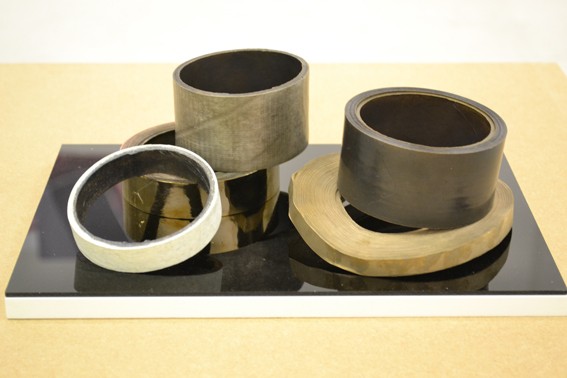
Every time I visit Hiroe Komai's studio I come out seeing the city with new eyes - the flimsiness of buildings, the odd details, the materials of which everything is made. Recently she has shifted from her architecture-inspired sculptures to casting small bronzes of objects in her studio. These have proved extremely popular, particularly with other artists. These are what are in this show.
Both Komai and Neil Zakiewicz take us back through 20th century art to the beginnings of modernism, to Constructivism, but these art references pause long around the 1960s and 1970s. Both artists make art about the making of art. Both are witty.
Zakiewicz's pieces are of MDF and have hinged wings or flaps of various shapes which can fold down from the sides or from top or bottom. They are spray-painted with the flaps closed, but exhibited with them open, so that the holes and cut-outs in the flaps leave painted shapes on the section underneath. They are like irregularly shaped altarpieces, but downbeat, made with DIY materials. These works are in a tradition with other painters who have made art about the making of paintings. He likes materials and processes to be obvious, not concealed. Their 'point' is to reveal the actions which produced them. They ought to be dry but they are far from it. 'In the end there has to be something to look at,' he says, 'something to contemplate,' and their elegance and allusiveness results in great subtlety. Among the many things he tells me he likes are Tantric paintings - 'because they have a function.' He adds, 'art has always had to do with religion, and really it still does, if it functions as a replacement for it, which I think it does.' His work's matter-of-fact approach leads to an idea of possibility.
Komai's bronzes are casts of tools and other useful objects in her studio: G-clamps, elastic bands, a hammer and nail, Blu-Tack, rolls of tape, pencils, screwdrivers, scalpels. And as if taking us through the door of the studio, her doorstop. Mostly it is the things she has always used to make sculpture. They are exquisitely crafted - it is hard to believe that their colours are achieved with patination alone. The result is that the making of work itself becomes a subject of the work. And like Zakiewicz's pieces they really bring with them a number of art-historical references, and beyond that, an idea of the devotion required to make art. She alludes to Mondrian in the boxes she makes to contain the sculptures, the floors of which use his colours: primaries, black and white. Like Zakiewicz's, her work is funny. It has always relied on a comical contrast of the utopianism and idealism of de Stijl, Russian Constructivism and so on, and contemporary interior decor of the DIY type. But the comedy is wistful and her formal journey is also always towards the contemplative. It's serious.
All the pieces in this show were made in part by someone else: Komai's by a bronze caster, Zakiewicz's by someone whose job it is to spray-paint furniture. But Zakiewicz makes his structures, Komai her moulds. And this collaboration, this giving of instructions, is also part of the work. In 1990 art theorist Michel Giroud wrote that, ‘since the beginning of the 20th century a huge upheaval has broken aesthetic comforts and established definitions, in favour of the beauty of the everyday.’ This is true, and relevant to Komai and Zakiewicz. But the art of the 'everyday' also has to deal with the history and nature of art, and where it can, with the things that art has always dealt with, with ideas about the world.
David Lillington, March 2014